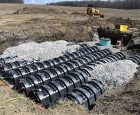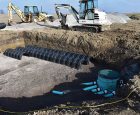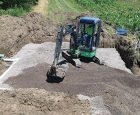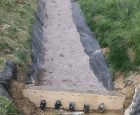
Features
Drainage Management Systems
Keeping phosphorus out of waterways
Phosphorus removal structures are helping to prevent phosphorus from entering waterways.
October 23, 2018 By Trudy Kelly Forsythe
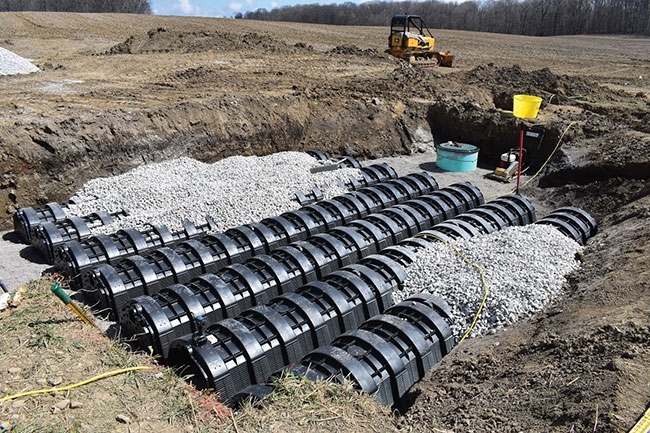 Construction of a subsurface tile drain P removal structure near Waterloo Phosphorus removal structures trap the nutrient before it reaches waterways.
Construction of a subsurface tile drain P removal structure near Waterloo Phosphorus removal structures trap the nutrient before it reaches waterways.While phosphorus is a necessary nutrient in agriculture, it is a water quality pollutant that must be prevented from excessively entering waterways. One way to do this is by minimizing erosion.
Chad Penn, a soil scientist with the United States Department of Agriculture, says there are many effective best management practices that minimize erosion, including no or reduced till and incorporating buffer strips.
That said, Penn adds that if soil phosphorus builds up high beyond the need of plants, even with erosion control to prevent particulate phosphorus from leaving the field, there can still be a loss of dissolved phosphorus.
“You would then have to prevent water from leaving a field to slow down the transport of dissolved phosphorus,” he says.
Phosphorus removal
Unlike nitrogen, which is very unstable in soil, once phosphorus reaches high levels in soil it stays high for a very long time – even if producers stop applying phosphorus and continue harvesting crops.
“You want between 15 and 30 milligrams per kilogram (mg/kg) of Mehlich-3 phosphorus in your soil; that’s all most agronomic crops need,” Penn says. “If it reaches 300 to 400 mg/kg, it can take around 20 to 30 years for it to get back down. During that long drawdown period, every flow event will leak a little bit of dissolved phosphorus.”
Phosphorus removal structures – structures that contain filters to intercept and trap dissolved phosphorus before it reaches waterways – are having a positive impact on preventing phosphorus from entering waterways. While the structures can appear in many different forms, and be located in a variety of areas including on the surface, in ditches or tile drains, Penn explains they must all have four basic principles:
- They must contain solid media with a high affinity for phosphorus, commonly known as a phosphorus sorption material;
- The phosphorus sorption material must be contained and placed in a hydrologically active area with high-dissolved phosphorus concentrations;
- High-dissolved phosphorus water must be able to flow through the contained phosphorus sorption material at a sufficient rate; and
- The phosphorus sorption material must be able to be removed and replaced after it is no longer effective.
Choosing a location
Penn says the location of a phosphorus removal structure should meet the following criteria to qualify as a potential site for construction of a phosphorus removal structure:
- Flow convergence must be at a point where water can be directed into a structure, or there must be an ability to manipulate the landscape
- There must be at least 0.2 ppm dissolved phosphorus in the water
- There must be sufficient hydraulic head for pushing the water through the structure by gravity; this is a function of the elevation change or of the drainage ditch depth
- The site must have sufficient space to accommodate phosphorus sorption material
Phrog
While a professor at Oklahoma State University, Penn helped develop a software package that is capable of designing landscape-scale filters that remove dissolved phosphorus from drainage water. Known as Phrog, the software needs several inputs and target goals to design a site-specific phosphorus removal structure.
“To do the design, you need to know how much phosphorus is leaving the site, what the concentration of dissolved phosphorus is and how much water per year is flowing through where the high phosphorus is,” Penn says. “We put that together to get the calculated load or total mass of dissolved phosphorus.”
Armed with that information, the designer decides what percentage of cumulative phosphorus to remove – Penn says he generally goes with 40 percent removal – over a certain number of years.
Design considerations
To achieve the input target, designers need to decide what flow rate they want the structure to handle. Peak flow rate is when the majority of phosphorus is lost in large flow events. If installing in a subsurface tile drain, contractors should assume the worst-case scenario that pipe could handle.
Other considerations if installing a structure in subsurface tile is how deep it is from the surface to the drain, whether to have the water flow down or upward through the media and what media to use to filter.
“You need to filter from the top down if you’re using an iron-rich filter media,” Penn says, explaining they tend to use industrial by-products for the filter media because they are typically readily available and less expensive. “Some manufactured materials tend to be really expensive, but if they’re really good, less material may be required.”
However, whenever industrial by-products are used they should first be tested for safety, especially for heavy metals. “It comes down to the structure’s ability to absorb phosphorus, to transmit water and safety,” Penn says.
A case study
Using Phrog, Alberta’s Agriculture and Forestry Department designed a phosphorus removal structure. The intent was to determine if the phosphorus filter is effective under Alberta’ environmental conditions, to create a demonstration site for producers and producer groups and to determine if the phosphorus filter technology is a cost-effective management option that can mitigate phosphorus loss and be a best management practice option for landscape and production systems in Alberta.
The filter was constructed using an American-manufactured phosphorus absorption media called BioMax Phosphorus Removal media. The phosphorus removal structure was installed in June of 2017 and early results are promising.
“Water sampling to date indicates phosphorus removal of approximately 90 percent,” says Ken Janzen, a project technologist. “The filter has performed quite well through the last winter season, freezing up several times for about a week each time, but then thawing to become operational again when temperatures rose above zero.”
Making it work
One of biggest obstacles to getting the phosphorus removal structures where they can do their jobs is finding competent people to design and build them.
“We need people trained on how to design the structures and we need an industry of competent people to take those designs and build them,” Penn says. “Drainage contractors could be those people. Whether or not they do the design, drainage contractors are in a good position to build it. They know drainage.”
Penn will soon work with Scott Cedarquist and Luther Smith of the American Society of Agricultural and Biological Engineers and American Society of Agronomy to create training videos on design and construction of phosphorus removal structures. These are intended to train and certify contractors in these areas.
Currently, Penn is conducting further research on how to make the phosphorus removal structures more economical through techniques such as re-generation of filter media.
For additional information on how to design a phosphorus removal structure, Penn has co-authored a book called Design and Construction of Phosphorus Removal Structures for Improving Water Quality with James Bowen. Published by Springer, it is available in e-book or hard copy.
Print this page
